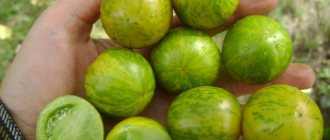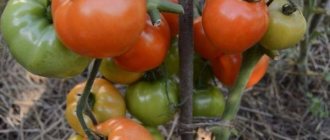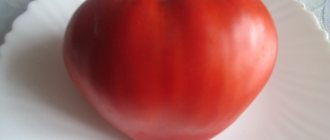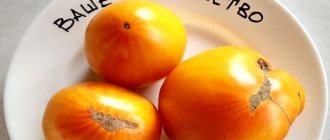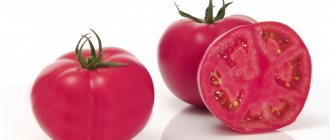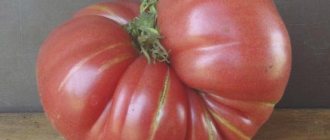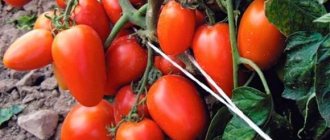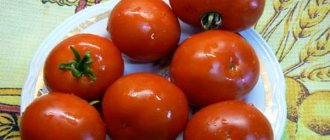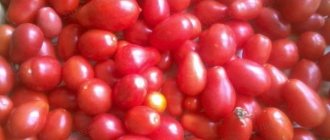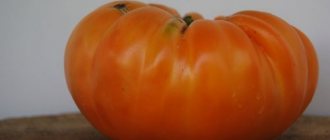Once upon a time, as children, we knew that tomatoes were red. Then yellow, crimson, and pink appeared. But so that ripe tomatoes are green inside? Yes, that time has come. Not just green, but emerald green. But at the same time very tasty. This is the original variety of the Siberian collection with the fabulous name Malachite Box.
- 2 Advantages and disadvantages, features and differences from other varieties
- 3 Features of planting and growing tomatoes Malachite box
- 4 Reviews
4.1 Video: characteristics of the Malachite box variety
Description of the tomato variety Malachite Box, its characteristics and growing region
The Malachite Box tomato is the result of the work of Novosibirsk resident Vladimir Nikolaevich Dederko and his associates, who have already obtained almost a hundred varieties and hybrids of tomatoes from the so-called “Siberian” collection. As a rule, these tomatoes are characterized by increased cold resistance and are able to grow in open ground in most regions. The malachite box is recommended for cultivation both in unprotected soil and in light greenhouses of private farms without regional restrictions. The variety is also known in neighboring countries. It was registered in the State Register of the Russian Federation in 2006.
The tomato is one of the indeterminate varieties; it grows as a tall bush, up to one and a half meters or more, and requires mandatory formation and tying. The leaves are large, dark green in color, the foliage of the bush is strong. The first fruit cluster is tied after the 9th or 10th leaf, the next ones every three leaves.
There are a lot of tomatoes on the bushes, you can’t do without a garter
The main purpose of the fruits is salad, since they are quite large, weighing on average 250–300 g. Half a kilogram specimens sometimes grow on the lowest tiers. The ripening period is average. Tomatoes are flat-round in shape, without ribs, with thin skin. According to the description, the color of ripe fruits is yellow, but at the stage when they are picked, the tomatoes do not yet turn completely yellow and appear striped: yellow stripes alternate with greenish ones. This “malachite” color gave the name to the tomato variety, but one must understand that in the “striped” state the fruits are only in a state of technical ripeness; later they should turn yellow completely. The flesh remains emerald green.
There are 4 or more seed nests, few seeds. The taste is rated as good or excellent, sweet. Gourmets call it exotic, slightly reminiscent of the taste of melon and kiwi. It is not surprising: after all, emerald, and often streaked, flesh is very unusual for ripe tomatoes. It is impossible to preserve tomatoes as a whole in jars, but various preparations are made from them, including even jam. The juice also tastes interesting, but its color is very unusual. Basically, people try to eat these tomatoes fresh.
Judging by the appearance of the fruits, an inexperienced gardener will say that it is too early to eat them.
Yields vary greatly depending on where the tomato is grown. In open ground it is low, only about 4.5 kg/m2, but in greenhouses it can reach up to 15 kg/m2 or more. Ripening is not simultaneous, fruiting is extended over time. The thin skin does not allow the crop to be transported over long distances. It doesn't store well; over time, the tomatoes become watery. The same trouble awaits tomatoes that are not picked on time: when left on the bushes, they taste worse and often crack. Unfortunately, it is difficult to accurately determine the harvest time due to the coloring of the fruits, and even this fact does not allow us to recommend the variety for cultivation to novice gardeners. This is also due to a certain capriciousness of the variety in care.
Description of the variety
Bred in 2006 in Novosibirsk by V. N. Dederko and O. Postnikova. Then it is entered into the state register, which gives the right to officially recognize it. It has a number of advantages, but there are also weaknesses. Let's take a closer look.
- Since the tomato was bred in Siberia, the main task was to create a plant that could withstand the harsh climate. They coped with the task “excellently”. The malachite box grows successfully both during temperature changes, in an unstable spring climate, and in the summer heat and dry days.
- The height of the bush reaches 1.5 m, the fruits are among the largest among tomatoes: from 200 to 900 g! Bred for cultivation both in greenhouses and in open ground.
- The bush needs gartering and pinching. Judging by the reviews, it is better to form the plant into 1 or 2 stems. If you plan to grow in 1 stem, then remove all the stepsons; if in 2, then leave one shoot under the first flower cluster. The inflorescence is simple in the Malachite Box, and the leaves are large in a rich green hue.
- The fruits are round and slightly flattened on top and bottom. Nest with seeds in a tomato 4. The hue is the main highlight, a delicate emerald green. At maturity it acquires a yellowish color.
- Tomato density is below average. Therefore, it is better to collect and eat immediately. The pulp is very tender. Very harmonious taste: moderate amount of acid and sugar.
- In a greenhouse, the harvest is more abundant - up to 15 kg per m2; in open ground, with proper care, you can harvest 4.3 - 4.5 kg per 1 m2.
Advantages:
- original taste with notes of fruit and spectacular appearance;
- can be grown both in open soil and under cover, film or agrofibre;
- excellent yield and germination;
- There are no empty flowers, all flowers that appear form ovaries;
- the variety is unpretentious and resistant to disease and cold;
- some prepare not only juices, but also amazing jam, which is obtained with a pronounced fruity taste;
- Since the fruits are not red, they can be consumed by people suffering from allergies. Moreover, the entire set of vitamins inherent in a tomato is present in this vegetable.
Flaws:
- not recommended for transportation, poor keeping quality;
- if you do not harvest on time, the fruits become too watery;
- It is difficult to determine when a tomato has actually reached ripeness.
But, if a vegetable has acquired a bronze tint, then it is necessary to eat it, since all green-fruited varieties are characterized by a loss of taste and density if they are not picked from the bush in time.
Advantages and disadvantages, features and differences from other varieties
The Malachite Box tomato is an unusual and controversial variety. Rather, it is for lovers of experiments and exoticism. Its non-standard nature is also manifested in the fact that, judging by the reviews of professionals and experienced amateurs, the number of its shortcomings is quite large, although there are many undoubted advantages. What is good about this variety? Most often, the advantages include:
- duration of fruiting (fruits on the bushes ripen several at a time from mid-late July until frost);
- exotic colors of ripening fruits and, in particular, their pulp;
- unusual taste with fruity notes;
- hypoallergenic, allowing these tomatoes to be used in children's and dietary foods;
- high resistance to cold and heat;
- good yield when grown in greenhouses.
The obvious disadvantages are:
- the difficulty of determining the readiness of fruits for harvesting (in unripe and overripe states, their taste is much worse);
- capriciousness in care;
- the impossibility of long-distance transportation and any long-term storage of crops;
- low yield in unprotected soil.
Of course, the main difference between the Malachite Box variety is the unusual appearance of the tomatoes. And if there are several dozen varieties with “stripes” on fruits in an unripe state, there are only a few of them with emerald green flesh. This is, for example, the Emerald Apple, the fruits of which not only have an excellent taste, but are also well stored. Their color, even in a state of removable maturity, remains almost green. The Emerald standard variety has much smaller tomatoes and the taste is rated only as good, but it grows as a low bush that is easier to care for.
The new variety Green Zebra also has medium-sized fruits, the name of which indicates the color of the outer surface of the fruit. The Zelenushka variety has very small fruits, weighing no more than 15 g. The taste of these varieties of tomatoes is good, but the variety with the unappetizing name Boloto has an excellent taste, and they ripen very early. Actually, in the collection of V.N. Dederko, Malachite Box is not the only green-fruited variety, but the Siberian Malachite tomato is somewhat inferior to it in terms of consumer qualities.
The Siberian Malachite tomato strongly resembles the Malachite Box, but its fruits are smaller and the taste is only good
What people say
Many people will learn about “Siberian malachite”. It's like word of mouth. Since I planted one myself for testing, and, of course, he liked it, conversations begin about what a good variety it is.
No wonder. Reviews from gardeners who grow this variety are really only good. Since this representative is not whimsical, tasty and has a beautiful appearance. It is often called “striped” because of the stripes that differ from the main color of the fruit.
One of the main positive aspects of this variety is resistance to various diseases. It can grow under any conditions, but, of course, the better they are, the greater the harvest.
Another nuance, most people believe that the variety came from Siberia. This is not entirely true. Like any other vegetable, Siberian malachite does not tolerate extreme cold. That is why you should not exaggerate and invent things to yourself, this is just a name and nothing more.
You will not regret if you buy yourself such a copy. He has a lot of positive qualities, so there will be no problems with him. The main thing is that finding such a variety and planting it is as easy as shelling pears.
Features of planting and growing tomatoes Malachite box
The Malachite Box variety is cold-resistant, but they prefer to grow it in film greenhouses, since greenhouse cultivation yields much higher yields, and the tallness of the bush allows it to occupy the entire useful volume of the structure, right up to the roof. In terms of ripening time, the variety is mid-season, so almost everywhere it is grown through the seedling stage.
Seeds are sown in boxes approximately 70 days before the intended transfer of seedlings to the garden bed. Despite the cold resistance of an adult plant, seedlings can still be planted only when night temperatures do not fall below 8–10 °C. Based on long-term observations of the climate in a particular region and the quality of the greenhouse, the seed sowing time is calculated. Caring for seedlings is usual, but you need to make sure that they do not outgrow: there is no need for unnecessary feeding, there should be enough light, and the first 4–6 days of seedlings should be spent at a temperature no higher than 16 ° C. A week before planting, the seedlings must be hardened off.
Malachite Box seedlings can grow quite tall
The planting density is low: 2–3 plants per square meter. The planting technique does not differ from that for other varieties; Malachite Box seedlings may grow too tall, then they are planted obliquely, removing the lower leaves, but so that the roots are no deeper than 10–15 cm. The stakes for tying are driven in immediately; if possible, it is better to build a trellis.
The irrigation regime is normal, but since fruiting is extended, when the first fruits ripen, watering does not stop completely, but only reduces the amount of water supplied. It is not recommended to overfeed tomatoes of this variety: the standard three feedings are enough (two weeks after planting the seedlings, at the beginning of flowering and when the first fruits grow to the size of a walnut). It is better to use organic infusions for feeding.
Most gardeners grow this tomato bush with two stems (or one, depending on planting density). The second stem is one of the well-placed first stepsons. The remaining stepsons that appear are systematically broken out, and the leaves under the first fruit cluster are also removed. Not only the stems are tied in several places, but also the brushes as the fruits become heavier: the stems of this tomato are fragile and can break under the weight of the harvest.
The Malachite Box bush is limited in height in the second half of summer
Information about the disease resistance of the variety is scanty, although it is known that most V.N. Dederko tomatoes are resistant to most diseases. However, preventive treatment will not hurt. In ordinary regions, it is enough to spray the bushes with infusions of wood ash or a weak solution of potassium permanganate, and in problem regions, where late blight often rages, the plants are treated a couple of times with copper-containing preparations.
Specifics of cultivation
It is advisable to grow the Malachite Box variety in a greenhouse, since it is easier to care for tall bushes, and the yield is larger.
Preparing soil and containers
The Malachite Box tomato grows well in fertile, light soils. A simple solution for growing seedlings is to buy a nutrient mixture at a specialty store. You can prepare the soil yourself - mix equal parts of humus, peat and turf soil. There is no need to specially fertilize the soil, since the seeds do not particularly require fertilizing to germinate. It is better to fertilize the soil after germination.
The planting material is planted in a wide box, which is pre-disinfected (doused with boiling water or a solution of potassium permanganate). The strengthened seedlings are later planted in separate containers.
Seed preparation
Self-collected planting material is first sorted. For this, tomato grains are placed in a malachite box in a slightly salted solution. For sowing, grains that have settled to the bottom are collected.
See also Description and characteristics of Japanese truffle tomato varieties
Preparation for germination is carried out in several stages:
- to disinfect grains, place them in a pale solution of potassium permanganate for 20-30 minutes, then remove them and wash them under running water;
- to increase crop productivity, planting material is soaked in special preparations that stimulate growth: “Epin”, “Immunocytophyte”;
- The grains for germination are wrapped in wet gauze or cloth and placed in a warm place. It is necessary to constantly maintain the moisture of the fabric.
In order for the seedlings to better tolerate temperature changes, the sprouted seeds are hardened - placed in the refrigerator for 10-12 hours. Then leave it in a warm place for the same time and repeat the cycle 2-3 times.
Sowing seeds
Before sowing the seeds, prepare the soil: grooves 1.5-2 cm deep are made on the surface (rows alternate with a distance of 3-4 cm).
The sprouted grains are placed in grooves in increments of 2-2.5 cm and sprinkled with a little soil. The containers are covered with film or glass and placed in a warm place. When the first shoots appear, the boxes are opened and transferred to a well-lit place. Recommended air temperature is 15-17°C. In heat and light, seedlings can stretch, so it is important to ensure that the temperature does not rise.
In cloudy weather, the containers are additionally illuminated. Watering should not be done sparingly, as the seedlings will simply rot if they are over-watered.
Picking
The advantage of the Raspberry Box variety is that the seedlings tolerate transplantation well. As soon as 3-4 leaves appear on the sprouts, you can safely dive the plants into separate containers. The picking cannot be underestimated - the seedlings are placed in new fertile soil, and more space appears for growing the root system.
After picking, the tomato seedlings are fed. The best option is to use organic matter. The use of wood ash has several advantages - the natural remedy contains the necessary microelements and prevents the appearance of blackleg in seedlings.
Watering of picked seedlings should be moderate. Stagnation of moisture should not be allowed, but the formation of a dried crust on the soil is not welcome.
Transfer
Hardened seedlings are transplanted into a greenhouse or open beds in late May - early June. The site is prepared for the event 7-10 days earlier. The soil is dug up and loosened. To increase the temperature of the earth, you can cover the beds with polyethylene. For disinfection purposes, the wells are watered with a hot solution of potassium permanganate.
They make transfers on a cloudy day or set aside time in the evening. A distance of 40-45 cm is made between the holes. After transplanting, the seedlings are immediately tied to a support. If the seedlings are too elongated, they are placed in the hole at an angle and several of the lower leaves are torn off.
Reviews
If you have not tried this variety or similar green fruits (Swamp, Emerald Apple), then you must do it at least once in your life. The Malachite Box variety has a pronounced sweet taste with a fruity tint, yes, fruity, not tomato. In this regard, he delights many forum users. But at the same time, you can quickly get bored with this taste and crave the real tomato taste. Then the problem may arise, what to do with the tomatoes. Don’t despair, there is always a way out, for example, based on Galina Esme’s experience, you can make green tomato juice. There are also untested proposals to make adjika or jam. But the main recommendation is to plant this variety in quantities of no more than 2 bushes only as an exotic.
News
https://www.tomat-pomidor.com/forums/topic/1220-%D0%BC%D0%B0%D0%BB%D0%B0%D1%85%D0%B8%D1%82%D0%BE %D0%B2%D0%B0%D1%8F-%D1%88%D0%BA%D0%B0%D1%82%D1%83%D0%BB%D0%BA%D0%B0/
Very beautiful tomato! Truly a box! Tasty, but I wouldn’t say it’s amazing. Maybe I tried it too early. It turned out to be a poor harvest.
Kate
https://www.tomat-pomidor.com/forums/topic/1220-%D0%BC%D0%B0%D0%BB%D0%B0%D1%85%D0%B8%D1%82%D0%BE %D0%B2%D0%B0%D1%8F-%D1%88%D0%BA%D0%B0%D1%82%D1%83%D0%BB%D0%BA%D0%B0/
I planted several malachite boxes, but only one bush survived. I really liked it. The consistency of the tomato is tender and sweet.
Arisha
https://dacha.wcb.ru/index.php?showtopic=52279
I grew the malachite box in a greenhouse for the first year. I definitely liked the taste, the early harvest, the yield. Now I won’t grow Swamp, MS is much better.
Tango
https://dacha.wcb.ru/index.php?showtopic=52279
I’m probably not much of a gardener, or the conditions in my greenhouse are not very good. The Malachite Box variety did not show itself at all. And for two years in a row. Three or four yellow-green tomatoes per bush and that’s it. The appearance, size, quantity, taste were not impressive. It was not possible to get striped chocolate, but we don’t hold dark, blue promidors in high esteem.
March
https://forum.prihoz.ru/viewtopic.php?t=7442&start=375
Features of cultivation and storage
The seedlings are transplanted to a stationary place if the bushes have 6-7 true leaves. By this time, the plants reach the age of 50 days.
Place 3-4 bushes per 1 m2. The optimal distance between holes is 40-50 cm.
How to care for tomatoes:
- the bushes lead into 2 trunks, with this method the yield is maximum;
- water once every 4-5 days, the water norm is 7-8 liters per plant;
- fed with organic matter and complex fertilizers - “Agricol”, “Kemira-universal”;
- mulch with a layer of straw 8-10 cm.
Tomatoes are picked either at full ripeness or earlier for ripening. The fruits are stored for up to 3 weeks in dark, cool rooms.
